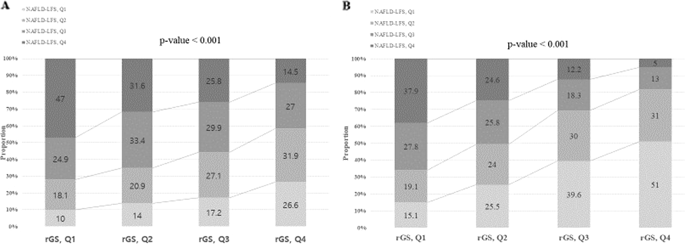European Journal of Clinical Nutrition ( IF 4.7 ) Pub Date : 2020-03-09 , DOI: 10.1038/s41430-020-0591-x Seung Ha Park 1 , Dong Joon Kim 2, 3 , Lindsay D Plank 4

|
Background/objectives
The purpose of this study was to examine the association between muscle weakness and non-alcoholic fatty liver disease (NAFLD), and whether the association is partly explained by insulin resistance or inflammation.
Subjects/methods
Subjects were 3922 adults who participated in the 2015 Korea National Health and Nutrition Examination Survey. Relative grip strength (rGS; calculated as maximal grip strength divided by BMI) was used to predict NAFLD defined by NAFLD liver fat score. Participants were classified into four groups according to the quartiles of rGS distribution (Q1–Q4). Insulin resistance was assessed by triglycerides and glucose (TyG) index. Inflammation was measured with C-reactive protein (CRP). Fibrosis was assessed by the Fibrosis-4 index (FIB-4) and the NAFLD fibrosis score.
Results
rGS had significant negative associations with TyG index and CRP (all p < 0.001). rGS was a significant predictor of NAFLD (OR, 0.54–0.19 in Q2–Q4 men; OR, 0.54–0.08 in Q2–Q4 women, all p < 0.001). Adjustment for other participant factors did not substantially affect the results. Addition of TyG index changed the estimates for NAFLD slightly and addition of CRP increased the ORs by 10–20% in Q3–Q4 women. In the subpopulation with NAFLD (n = 946), rGS showed strong inverse relationships with FIB-4 and NAFLD fibrosis score (all p < 0.001).
Conclusions
Grip strength was inversely associated not only with the risk of NAFLD but also with its severity. Insulin resistance and inflammation explained only a small portion of the association between grip strength and NAFLD risk.
中文翻译:

握力与非酒精性脂肪肝的关联:胰岛素抵抗和炎症作为介质的作用研究
背景/目标
这项研究的目的是检查肌肉无力与非酒精性脂肪肝疾病(NAFLD)之间的关联,以及该关联是否部分归因于胰岛素抵抗或炎症。
主题/方法
受试者为3922名成年人,他们参加了2015年韩国国民健康与营养检查调查。相对握力(rGS;计算为最大握力除以BMI)用于预测由NAFLD肝脂肪评分定义的NAFLD。根据rGS分布的四分位数(Q1-Q4)将参与者分为四组。通过甘油三酸酯和葡萄糖(TyG)指数评估胰岛素抵抗。用C反应蛋白(CRP)测定炎症。纤维化通过纤维化4指数(FIB-4)和NAFLD纤维化评分进行评估。
结果
rGS与TyG指数和CRP显着负相关(所有p <0.001)。rGS是NAFLD的重要预测指标(OR,Q2-Q4男性为0.54-0.19; OR,Q2-Q4女性为0.54-0.08,所有p <0.001)。其他参与者因素的调整对结果没有实质性影响。TyG指数的增加略微改变了NAFLD的估计值,而CRP的增加使Q3至Q4妇女的OR升高了10-20%。在具有NAFLD的亚人群(n = 946)中,rGS与FIB-4和NAFLD纤维化评分显示出强烈的反比关系(所有p <0.001)。
结论
握力不仅与NAFLD的风险成正比,而且与它的严重程度成反比。胰岛素抵抗和炎症仅解释了握力和NAFLD风险之间的一小部分。



























 京公网安备 11010802027423号
京公网安备 11010802027423号